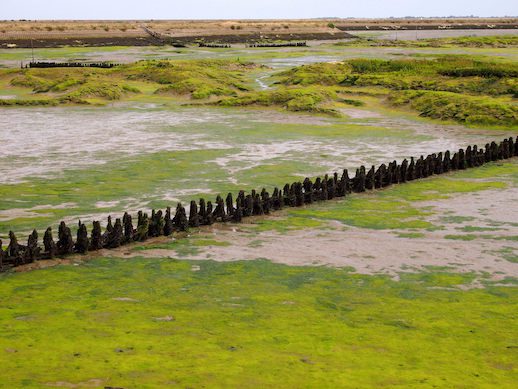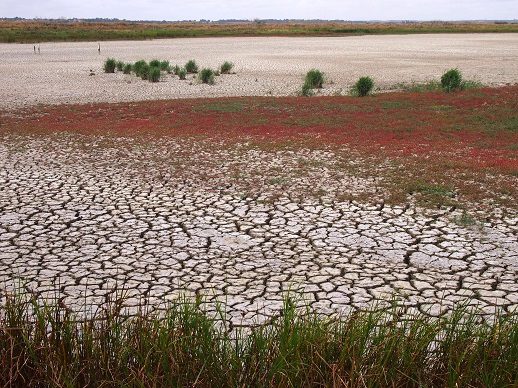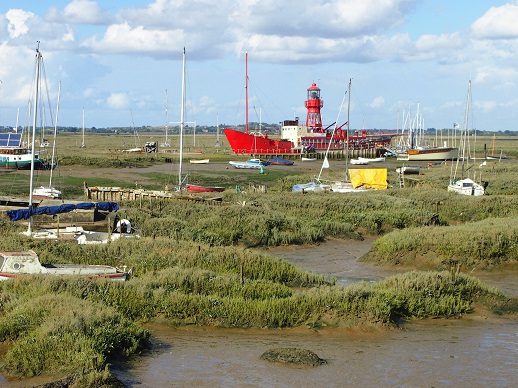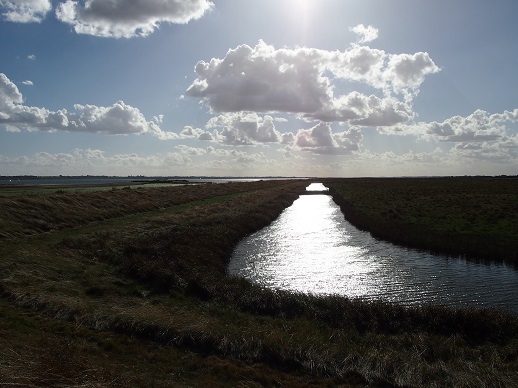Words and images by Tom Bolton
The autumn equinox had brought a delayed shift, a collective groping towards normality after a summer of ominous political change. Jeremy Corbyn had been re-elected as Labour leader that day with an increased majority, leaving 300,000 people feeling very optimistic. The rest seemed less sure. The route east, which Jo and I had become used to taking on our regular trips to Essex, was closed. We made our way to Newbury Park, an unlikely spot in Zone 4, where a bus was on offer. The Central Line station was dominated by a copper-roofed, concrete, barrel-vaulted structure, an austere 1940s statement of intent. The journey became a modernist field trip as we cruised past beltway bungalows lining the A12, traversing the bypass sprawl of Havering, Gallows Corner and Harold Wood, an indefinable zone where London and Essex become one.
Colchester, familiar after a summer of visits, was our destination for a final time. On the western edge of the town Lexden Mound was said to be the burial place of Cymbeline, king of the lost eastern Celts. We had seen Shakespeare’s play two days earlier at the Globe, where it had received an urban makeover. Cymbeline was a drug dealer clad in North Face, while Belarius had retreated to the Welsh hills to grow skunk. It was billed as the London Cymbeline, but the accents seemed definitively Essex.
The days had become suddenly shorter and Saturday nights started sooner. The High Street bars were packed, everyone dressed for intensive enjoyment. An SOS Bus offered water, emergency first aid or somewhere to retreat if you were “feeling threatened”. There were more people begging on the street than we could reasonably account for, and they seemed very young.
Our bed and breakfast was timber-framed, standard for Colchester, but the bookshelves stocked with Bruno Bettelheim, Arthur Koestler and Ayn Rand were not. Our fellow guest, a gentlemen in his 60s, trim white moustache and linen suit, had just flown in from Thailand. The Snake Brand talc in the bathroom presumably belonged to him.
Our coastal route was taking us to some of the most isolated of the Essex marshes, beyond Tollesbury, a village on the Blackwater Estuary. A taxi was the only transport available, but the driver complained that his company had been plagued by phantom call-outs to isolated spots out on the marshes. When the car arrived, there was no passenger to be found. We drove across the Abberton Reservoir dam, the Dambusters’ pre-raid training run, seeing the barrel bombs as they kissed the water and came spinning towards us.
The seawall tracked the outer limits of Old Hall Marshes, a lolling tongue of land. Its meandering edge was ten miles around, and the place was deserted. The map named just two features: Quince’s Corner and Joyce’s Head, and a couple of creeks. We walked the weaving causeway, raised above waterlogged channels and mud formations electric green with eelgrass. We met a single person, a trail runner who approached very gradually from the far horizon. When we eventually met, the three of us performed an awkward, silent dance on the narrow bank top, surrounded by cows and water.
The dome of the sky and the sharp, spirit-level skyline made it only possible to focus either on the vast, estuarine cloudscape, or the tiny detail of the marsh grasses. On the saltings redshanks, the ‘sentinels of the marsh’, squeaked like car alarms. Reed banks, rustling like dry paper in the breeze, provided the ambient soundtrack. In the distance, the twin nuclear reactors at Bradwell-on-Sea came into view, its concrete slab walls changing colour with the sky. When we reached Pennyhole Fleet, marked on the OS map in lake blue, its bed was cracked, white mud, the driest spot in the driest county in Britain.
We arrived at Tollesbury, perceptions eroded by the sensory deprivation of Old Hall Marshes, shut under a soft grey lid. On the outskirts of the village we crossed the route of the lost Kelvedon and Tollesbury railway, which had provided transport to the Tiptree jam factory. The fields outside Tollesbury had been known for their crop of strawberries, grown here by Wilkin and Sons to make Little Scarlet jam, a temperamental variety still prized for the small fruit suspected intact in the jar. The line, which had a single locomotive, had closed in 1951 due to lack of traffic.
The landlord of the pub in Tollesbury, speaking from behind a huge platter of cheese, assured us there was no food. The marina was a different proposition, activity in the village focused on the Hard. A retired lightship was moored offshore in Woodrolfe Creek where small boats lurked in muddy channels, waiting for the tide to float them free. This had been a fishing port, specialising in clams and oysters, with a fleet of expert boatmen. The reputation of Tollesbury’s sailors was high, and they were sought after for the skills they honed in harsh east winds and on shifting mudflats. During the 1930s sailors from the Blackwater and the Colne crewed Britain’s America’s Cup yachts. The entire crew of the 1930 challenger, Shamrock V, came from Tollesbury.
The autumn hedges were in full fruit, and Tollesbury Marshes was loaded an impossible crop of blackberries, haws and rosehips. The sloes were gone though, just a single fruit clinging on here and there. These marshes had been used since pre-history to refine salt. ‘Red hills’, first excavated here, could be discerned – low mounds on the flatlands. They contained the remains of the charcoal, ash, and clay remains of salt pans, built as early as the Bronze Age and continued by the Romans.
A ship with black sails, the sun behind it, slipped silently into the Blackwater. Bradwell was closer now, an uninscribed monument to a disaster yet to occur. Then we rounded the corner, turning back inland with the coast. A strong south wind came at us off the estuary: an auster, as the Romans called it, threatening sea mists. But the sun still shone at late summer strength, reflecting off the water of the dyke to reveal a glittering path west like one of Alfred Watkins’ ley lines, tracks of light across the Herefordshire valleys.
We passed the site of Tollesbury Pier, reduced to a grassy strip over the saltings. The Crab and Winkle Line, as the Tollesbury railway was known, had been a failed attempt to jump start the tourist trade, ferrying holidaymakers to the Blackwater Estuary. The railway was extended from the village to the pier but was not the anticipated success. It was requisitioned by the Army in the First World War and demolished in the Second, to strengthen the porous Essex coast.
We had talked the spooked cab company into coming back for us. The driver was ex-Army, staying on in Colchester when his posting ended to marry a local girl like, he said, many others. It seemed a long journey to Newbury Park, but the marshes had been necessary and fortifying. Jah Wobble sang of “Land reclaimed, my soul reclaimed”, found at the end of the A13. The A12 also had much to offer, but we would not be returning to Colchester in the foreseeable future. We were done with the Blackwater, the Colne, Mersea and the marshes. Our next visit would see us in fresh territory, working past Walton-on-the-Naze to different marshes, this time on the Stour. The Essex county boundary was almost within our grasp.
*
Tom Bolton on Caught by the River/on Twitter



